日本饮食文化介绍 英文
- 格式:ppt
- 大小:1.98 MB
- 文档页数:12
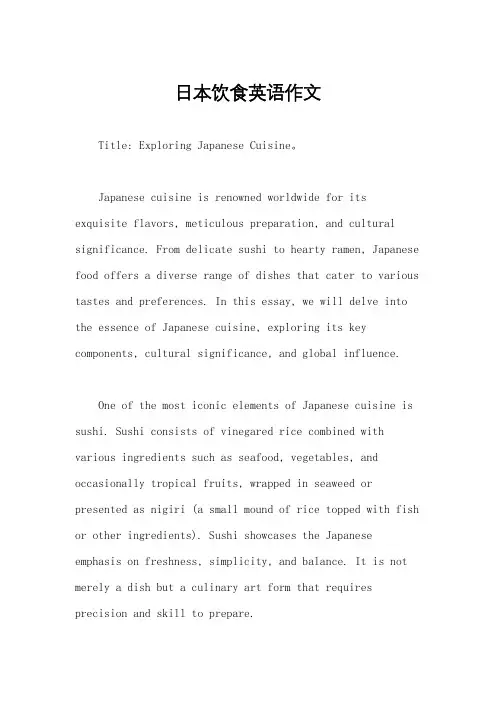
日本饮食英语作文Title: Exploring Japanese Cuisine。
Japanese cuisine is renowned worldwide for itsexquisite flavors, meticulous preparation, and cultural significance. From delicate sushi to hearty ramen, Japanese food offers a diverse range of dishes that cater to various tastes and preferences. In this essay, we will delve into the essence of Japanese cuisine, exploring its key components, cultural significance, and global influence.One of the most iconic elements of Japanese cuisine is sushi. Sushi consists of vinegared rice combined with various ingredients such as seafood, vegetables, and occasionally tropical fruits, wrapped in seaweed or presented as nigiri (a small mound of rice topped with fish or other ingredients). Sushi showcases the Japanese emphasis on freshness, simplicity, and balance. It is not merely a dish but a culinary art form that requires precision and skill to prepare.Another beloved Japanese dish is ramen. Originatingfrom China, ramen has evolved into a staple of Japanese cuisine. It features wheat noodles served in a flavorful broth, often accompanied by toppings such as sliced pork, green onions, bamboo shoots, and soft-boiled eggs. Ramen comes in numerous regional variations, each with its own distinctive broth and toppings, reflecting the diverse culinary landscape of Japan.Tempura is another popular Japanese dish known for its light, crispy batter and tender, flavorful ingredients. Tempura typically consists of seafood and vegetables dipped in a batter made from wheat flour, eggs, and ice-cold water, then deep-fried to perfection. It is often served with a dipping sauce and grated daikon radish, adding a refreshing contrast to the richness of the dish.Japanese cuisine also places great emphasis on seasonality and presentation. Kaiseki, a traditional multi-course meal, exemplifies this philosophy. It features a meticulously curated selection of dishes that highlight thefreshest seasonal ingredients, served in an aesthetically pleasing manner. Kaiseki is not just a meal but a sensory experience that engages sight, smell, and taste, inviting diners to appreciate the beauty of nature through food.The cultural significance of Japanese cuisine extends beyond its culinary delights. It reflects the values of harmony, respect, and mindfulness deeply ingrained in Japanese culture. The meticulous preparation and presentation of food, known as "washoku," emphasize the importance of balance and moderation in all aspects of life. Moreover, dining etiquette plays a significant role in Japanese society, with customs such as saying "itadakimasu" before a meal and "gochisosama deshita" after finishing to express gratitude and respect for the food and those who prepared it.In recent years, Japanese cuisine has gained global recognition and popularity, thanks to its emphasis on health, freshness, and umami—the fifth basic taste. Sushi bars and ramen shops can be found in major cities aroundthe world, catering to a diverse international clientele.Moreover, Japanese ingredients such as soy sauce, miso, and seaweed have become pantry staples in many households, inspiring chefs and home cooks alike to experiment with Japanese flavors and techniques.In conclusion, Japanese cuisine is a treasure trove of flavors, textures, and cultural significance. From sushi to ramen to tempura, each dish tells a story of tradition, innovation, and reverence for nature's bounty. As we continue to explore and appreciate Japanese cuisine, we not only satisfy our taste buds but also deepen our understanding of a rich and vibrant culinary heritage that transcends borders and brings people together in the spirit of shared enjoyment and appreciation.。

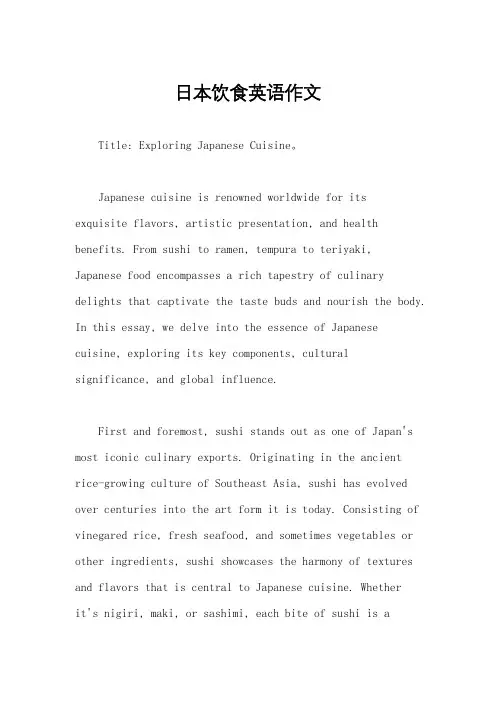
日本饮食英语作文Title: Exploring Japanese Cuisine。
Japanese cuisine is renowned worldwide for itsexquisite flavors, artistic presentation, and health benefits. From sushi to ramen, tempura to teriyaki, Japanese food encompasses a rich tapestry of culinary delights that captivate the taste buds and nourish the body. In this essay, we delve into the essence of Japanese cuisine, exploring its key components, cultural significance, and global influence.First and foremost, sushi stands out as one of Japan's most iconic culinary exports. Originating in the ancientrice-growing culture of Southeast Asia, sushi has evolved over centuries into the art form it is today. Consisting of vinegared rice, fresh seafood, and sometimes vegetables or other ingredients, sushi showcases the harmony of textures and flavors that is central to Japanese cuisine. Whetherit's nigiri, maki, or sashimi, each bite of sushi is atestament to the meticulous craftsmanship and reverence for ingredients that define Japanese culinary traditions.Another staple of Japanese cuisine is ramen, a hearty noodle soup that has captured the hearts of food enthusiasts around the globe. Originally introduced to Japan from China, ramen has undergone countless regional variations and innovations, resulting in a diverse array of styles and flavors. From the rich, pork-based broth of tonkotsu ramen to the clear, soy sauce-based broth of shoyu ramen, each bowl offers a unique gastronomic experience. Topped with an assortment of ingredients such as sliced pork, soft-boiled eggs, and nori seaweed, ramen embodies the comforting warmth and soul-nourishing qualities that are synonymous with Japanese comfort food.Tempura, a cooking technique introduced to Japan by Portuguese missionaries in the 16th century, has also become an integral part of Japanese cuisine. Consisting of lightly battered and deep-fried seafood, vegetables, and sometimes even fruit, tempura is prized for its delicate crunch and clean, fresh flavors. Whether it's shrimp, sweetpotato, or eggplant, each ingredient is carefully selected and prepared to achieve the perfect balance of crispiness and tenderness. Served with a dipping sauce made from soy sauce, dashi, and mirin, tempura exemplifies the Japanese aesthetic of simplicity and refinement.Teriyaki, a cooking technique characterized by the sweet and savory glaze made from soy sauce, mirin, and sugar, is another hallmark of Japanese cuisine. Originally used to preserve and flavor grilled fish, teriyaki has since become a popular marinade and sauce for a variety of meats, including chicken, beef, and pork. The caramelization of the sugars in the glaze creates a glossy finish and a depth of flavor that is both satisfying and addictive. Whether it's served over a bed of rice or alongside grilled vegetables, teriyaki adds a touch of umami-richness to any dish it graces.Beyond its delectable flavors and culinary techniques, Japanese cuisine holds deep cultural significance for the Japanese people. Food plays a central role in Japanese society, serving as a means of socializing, celebrating,and expressing gratitude. Traditional Japanese meals are often enjoyed in the company of family and friends, with each dish carefully prepared and presented to honor both the ingredients and the guests. From elaborate kaiseki meals to casual izakaya fare, Japanese cuisine reflects the country's reverence for nature, craftsmanship, and hospitality.In recent decades, Japanese cuisine has experienced a surge in popularity on the global stage, with Japanese restaurants opening in cities around the world and Japanese ingredients becoming more readily available in supermarkets and specialty stores. The rise of sushi bars, ramen shops, and izakayas outside of Japan speaks to the universal appeal of Japanese flavors and culinary aesthetics. Moreover, the emphasis on fresh, seasonal ingredients and simple yet elegant preparation techniques resonates with contemporary notions of health and sustainability, further fueling the global demand for Japanese cuisine.In conclusion, Japanese cuisine is a celebration of flavors, textures, and traditions that continue tocaptivate and inspire food lovers around the world. From the delicate artistry of sushi to the comforting warmth of ramen, each dish tells a story of centuries-old culinary craftsmanship and cultural heritage. As Japan's culinary influence continues to spread across the globe, the legacy of Japanese cuisine will endure as a testament to the enduring power of food to nourish the body, delight the senses, and bring people together in fellowship and joy.。

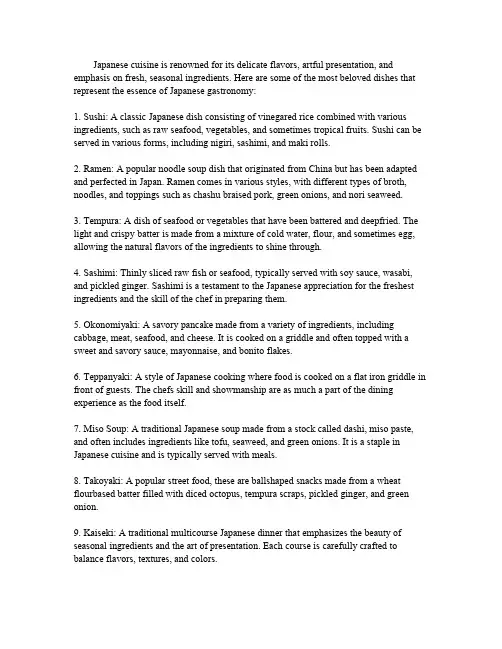
Japanese cuisine is renowned for its delicate flavors,artful presentation,and emphasis on fresh,seasonal ingredients.Here are some of the most beloved dishes that represent the essence of Japanese gastronomy:1.Sushi:A classic Japanese dish consisting of vinegared rice combined with various ingredients,such as raw seafood,vegetables,and sometimes tropical fruits.Sushi can be served in various forms,including nigiri,sashimi,and maki rolls.2.Ramen:A popular noodle soup dish that originated from China but has been adapted and perfected in Japan.Ramen comes in various styles,with different types of broth, noodles,and toppings such as chashu braised pork,green onions,and nori seaweed.3.Tempura:A dish of seafood or vegetables that have been battered and deepfried.The light and crispy batter is made from a mixture of cold water,flour,and sometimes egg, allowing the natural flavors of the ingredients to shine through.4.Sashimi:Thinly sliced raw fish or seafood,typically served with soy sauce,wasabi, and pickled ginger.Sashimi is a testament to the Japanese appreciation for the freshest ingredients and the skill of the chef in preparing them.5.Okonomiyaki:A savory pancake made from a variety of ingredients,including cabbage,meat,seafood,and cheese.It is cooked on a griddle and often topped with a sweet and savory sauce,mayonnaise,and bonito flakes.6.Teppanyaki:A style of Japanese cooking where food is cooked on a flat iron griddle in front of guests.The chefs skill and showmanship are as much a part of the dining experience as the food itself.7.Miso Soup:A traditional Japanese soup made from a stock called dashi,miso paste, and often includes ingredients like tofu,seaweed,and green onions.It is a staple in Japanese cuisine and is typically served with meals.8.Takoyaki:A popular street food,these are ballshaped snacks made from a wheat flourbased batter filled with diced octopus,tempura scraps,pickled ginger,and green onion.9.Kaiseki:A traditional multicourse Japanese dinner that emphasizes the beauty of seasonal ingredients and the art of presentation.Each course is carefully crafted to balance flavors,textures,and colors.10.Donabe Cooking:A method of cooking that uses traditional clay pots called donabe. This method is known for its ability to retain heat and evenly distribute it,resulting in dishes with deep flavors.11.Katsu:A dish where meat,usually pork,is breaded and deepfried.It is typically served with a bowl of rice,miso soup,and pickled vegetables.12.Onigiri:Rice balls that are often filled with pickled plum,salmon,or other ingredients and wrapped in seaweed.They are a popular snack and a staple in Japanese lunchboxes.13.ShabuShabu:A Japanese hot pot dish where thinly sliced meat and vegetables are cooked at the table in a pot of boiling water or broth.14.Yakitori:Skewered and grilled chicken pieces,often seasoned with a sweet and savory sauce.Yakitori is a popular dish in izakayas,Japanesestyle pubs.15.Matcha:A type of powdered green tea that is used in traditional Japanese tea ceremonies and also in modern confectionery and desserts.These dishes are just a glimpse into the rich and diverse culinary landscape of Japan, where the art of cooking is deeply intertwined with culture and tradition.。
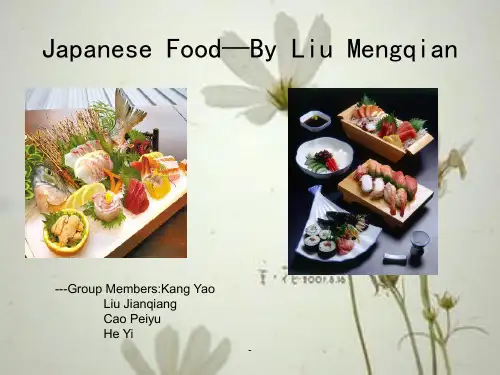
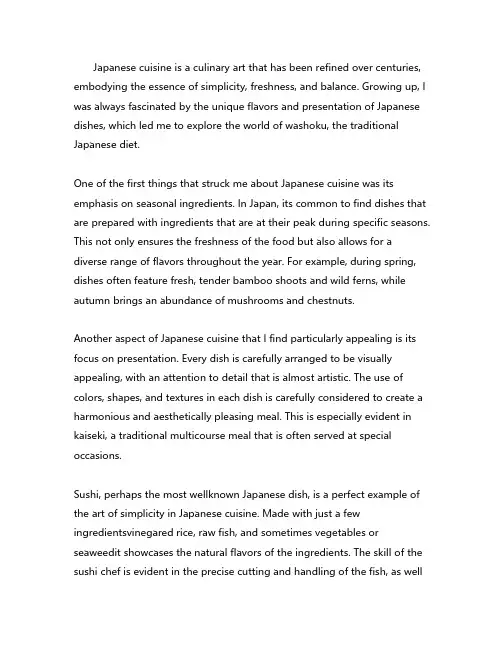
Japanese cuisine is a culinary art that has been refined over centuries, embodying the essence of simplicity, freshness, and balance. Growing up, I was always fascinated by the unique flavors and presentation of Japanese dishes, which led me to explore the world of washoku, the traditional Japanese diet.One of the first things that struck me about Japanese cuisine was its emphasis on seasonal ingredients. In Japan, its common to find dishes that are prepared with ingredients that are at their peak during specific seasons. This not only ensures the freshness of the food but also allows for a diverse range of flavors throughout the year. For example, during spring, dishes often feature fresh, tender bamboo shoots and wild ferns, while autumn brings an abundance of mushrooms and chestnuts.Another aspect of Japanese cuisine that I find particularly appealing is its focus on presentation. Every dish is carefully arranged to be visually appealing, with an attention to detail that is almost artistic. The use of colors, shapes, and textures in each dish is carefully considered to create a harmonious and aesthetically pleasing meal. This is especially evident in kaiseki, a traditional multicourse meal that is often served at special occasions.Sushi, perhaps the most wellknown Japanese dish, is a perfect example of the art of simplicity in Japanese cuisine. Made with just a few ingredientsvinegared rice, raw fish, and sometimes vegetables or seaweedit showcases the natural flavors of the ingredients. The skill of the sushi chef is evident in the precise cutting and handling of the fish, as wellas the perfect seasoning of the rice.Ramen, another popular Japanese dish, is a testament to the versatility of Japanese cuisine. With its rich, flavorful broth and customizable toppings, ramen has become a staple in Japanese cuisine and has gained popularity worldwide. The broth can be made from a variety of bases, such as chicken, pork, or even vegetable, and is often seasoned with soy sauce, miso, or salt. Toppings can range from thin slices of pork to softboiled eggs, bamboo shoots, and seaweed.Tempura is yet another dish that highlights the delicate balance of flavors in Japanese cuisine. Lightly battered and deepfried, tempura is made with a variety of ingredients, from seafood to vegetables. The key to a good tempura is the batter, which should be light and crispy, allowing the natural flavors of the ingredients to shine through.One of the most unique aspects of Japanese cuisine is its use of fermentation. Miso, a fermented soybean paste, is a staple in Japanese kitchens and is used in a variety of dishes, from soups to marinades. Fermented rice, known as koji, is also used to make sake, a traditional Japanese alcoholic beverage, and to season dishes with a unique umami flavor.In recent years, Japanese cuisine has gained international recognition, with washoku being designated as an Intangible Cultural Heritage by UNESCO. This has led to a growing interest in Japanese food culture, with more people seeking to learn about and experience the flavors and techniquesof Japanese cooking.In conclusion, Japanese cuisine is a rich and diverse culinary tradition that offers a unique blend of flavors, textures, and presentation. From the simplicity of sushi to the complexity of kaiseki, each dish is a testament to the skill and artistry of Japanese chefs. As someone who has always been fascinated by Japanese food, I am grateful for the opportunity to explore and appreciate this incredible cuisine.。
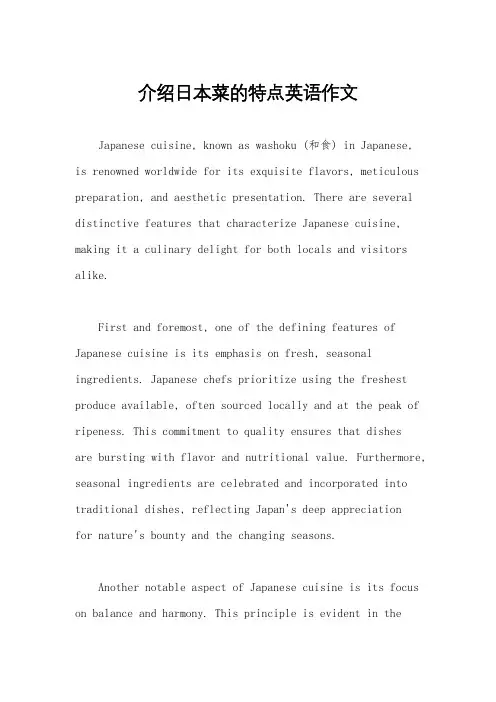
介绍日本菜的特点英语作文Japanese cuisine, known as washoku (和食) in Japanese,is renowned worldwide for its exquisite flavors, meticulous preparation, and aesthetic presentation. There are several distinctive features that characterize Japanese cuisine, making it a culinary delight for both locals and visitors alike.First and foremost, one of the defining features of Japanese cuisine is its emphasis on fresh, seasonal ingredients. Japanese chefs prioritize using the freshest produce available, often sourced locally and at the peak of ripeness. This commitment to quality ensures that dishesare bursting with flavor and nutritional value. Furthermore, seasonal ingredients are celebrated and incorporated into traditional dishes, reflecting Japan's deep appreciationfor nature's bounty and the changing seasons.Another notable aspect of Japanese cuisine is its focus on balance and harmony. This principle is evident in themeticulous arrangement of dishes, as well as the careful selection of ingredients to create a harmonious blend of flavors, colors, and textures. A typical Japanese mealoften consists of a variety of small dishes, each thoughtfully prepared to complement the others and providea well-rounded dining experience. This attention to balance extends beyond just taste to encompass aesthetic elements, with dishes often arranged to please the eye as well as the palate.Additionally, Japanese cuisine is renowned for its simplicity and elegance. While some dishes may require intricate preparation techniques, the overall philosophy of Japanese cooking emphasizes simplicity and minimalism. This is reflected in the use of clean, subtle flavors that allow the natural essence of the ingredients to shine through. From delicate sashimi to comforting bowls of steaming ramen, Japanese cuisine celebrates the beauty of simplicity, proving that less can indeed be more when it comes toflavor and enjoyment.Furthermore, Japanese cuisine places great importanceon presentation, with dishes often arranged with meticulous attention to detail. The concept of "shun" (旬), or seasonality, is also deeply ingrained in Japanese culinary tradition. This means that dishes are not only visually appealing but also reflect the season in which they are enjoyed, further enhancing the dining experience.Another hallmark of Japanese cuisine is its diverse range of cooking techniques. From the precise art of sushi-making to the hearty comfort of grilled yakitori, Japanese chefs employ a wide array of methods to create dishes that are both delicious and visually striking. Whether it's the intricate knife skills of a sushi chef or the deft hand of a tempura master, Japanese cuisine showcases a rich tapestry of culinary craftsmanship.In conclusion, Japanese cuisine is characterized by its emphasis on fresh, seasonal ingredients, balance and harmony, simplicity and elegance, meticulous presentation, and diverse cooking techniques. These features combine to create a culinary experience that is as aestheticallypleasing as it is delicious, making Japanese cuisine truly one of the world's culinary treasures.。
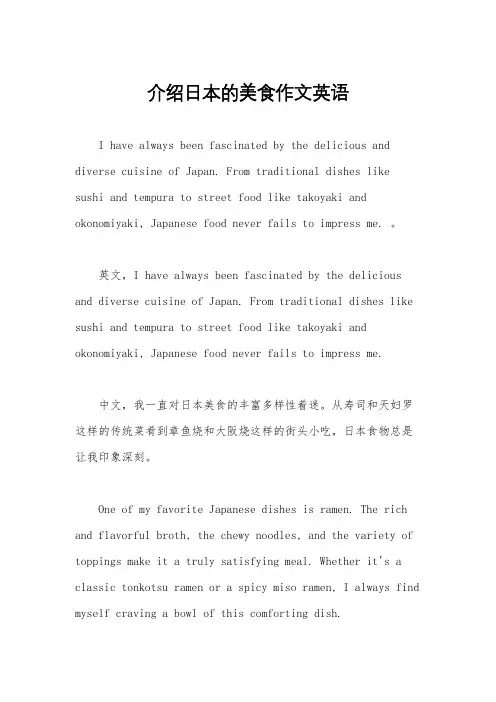
介绍日本的美食作文英语I have always been fascinated by the delicious and diverse cuisine of Japan. From traditional dishes like sushi and tempura to street food like takoyaki and okonomiyaki, Japanese food never fails to impress me. 。
英文,I have always been fascinated by the delicious and diverse cuisine of Japan. From traditional dishes like sushi and tempura to street food like takoyaki and okonomiyaki, Japanese food never fails to impress me.中文,我一直对日本美食的丰富多样性着迷。
从寿司和天妇罗这样的传统菜肴到章鱼烧和大阪烧这样的街头小吃,日本食物总是让我印象深刻。
One of my favorite Japanese dishes is ramen. The rich and flavorful broth, the chewy noodles, and the variety of toppings make it a truly satisfying meal. Whether it's a classic tonkotsu ramen or a spicy miso ramen, I always find myself craving a bowl of this comforting dish.英文,One of my favorite Japanese dishes is ramen. The rich and flavorful broth, the chewy noodles, and thevariety of toppings make it a truly satisfying meal. Whether it's a classic tonkotsu ramen or a spicy miso ramen, I always find myself craving a bowl of this comforting dish.中文,我最喜欢的日本料理之一是拉面。
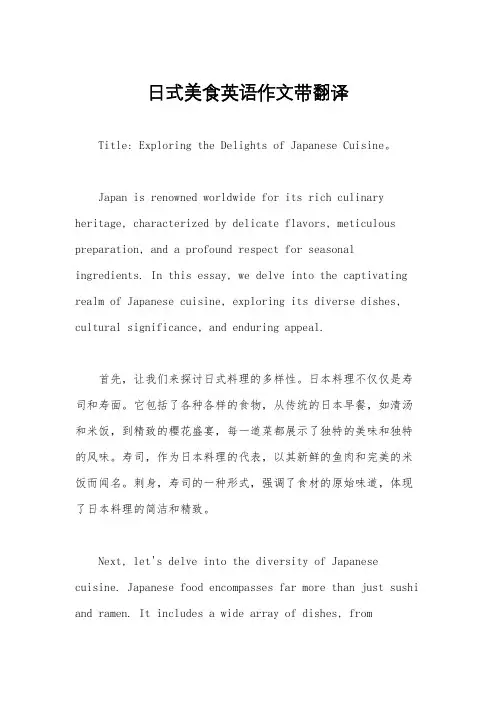
日式美食英语作文带翻译Title: Exploring the Delights of Japanese Cuisine。
Japan is renowned worldwide for its rich culinary heritage, characterized by delicate flavors, meticulous preparation, and a profound respect for seasonal ingredients. In this essay, we delve into the captivating realm of Japanese cuisine, exploring its diverse dishes, cultural significance, and enduring appeal.首先,让我们来探讨日式料理的多样性。
日本料理不仅仅是寿司和寿面。
它包括了各种各样的食物,从传统的日本早餐,如清汤和米饭,到精致的樱花盛宴,每一道菜都展示了独特的美味和独特的风味。
寿司,作为日本料理的代表,以其新鲜的鱼肉和完美的米饭而闻名。
刺身,寿司的一种形式,强调了食材的原始味道,体现了日本料理的简洁和精致。
Next, let's delve into the diversity of Japanese cuisine. Japanese food encompasses far more than just sushi and ramen. It includes a wide array of dishes, fromtraditional Japanese breakfasts featuring miso soup and rice, to elaborate cherry blossom feasts where each dish showcases unique flavors and textures. Sushi, as a quintessential representation of Japanese cuisine, is renowned for its fresh fish and perfectly seasoned rice. Sashimi, a form of sushi, emphasizes the purity of ingredients, reflecting the simplicity and refinement of Japanese cuisine.日本料理的文化意义也不容忽视。
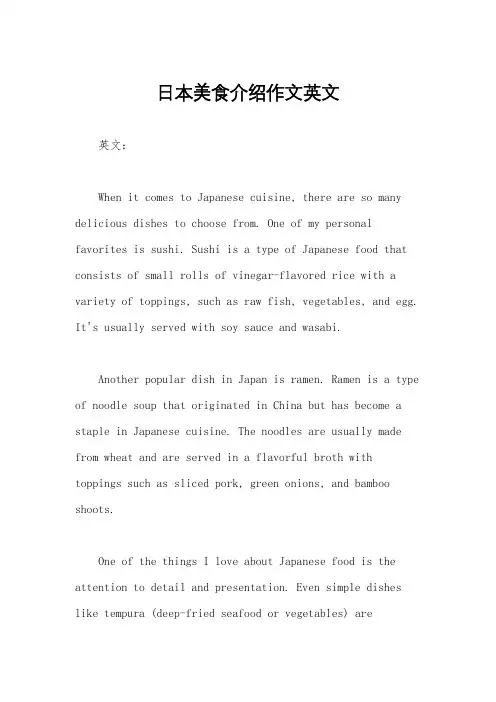
日本美食介绍作文英文英文:When it comes to Japanese cuisine, there are so many delicious dishes to choose from. One of my personal favorites is sushi. Sushi is a type of Japanese food that consists of small rolls of vinegar-flavored rice with a variety of toppings, such as raw fish, vegetables, and egg. It's usually served with soy sauce and wasabi.Another popular dish in Japan is ramen. Ramen is a type of noodle soup that originated in China but has become a staple in Japanese cuisine. The noodles are usually made from wheat and are served in a flavorful broth with toppings such as sliced pork, green onions, and bamboo shoots.One of the things I love about Japanese food is the attention to detail and presentation. Even simple dishes like tempura (deep-fried seafood or vegetables) arecarefully prepared and arranged on the plate to create a visually pleasing dish.Overall, Japanese cuisine is known for its fresh ingredients, delicate flavors, and beautiful presentation.It's no wonder why it's so popular around the world.中文:说到日本美食,有很多美味的菜肴可供选择。
日本饮食英语作文Japanese Cuisine。
Japanese cuisine is known for its diversity and unique flavors. From sushi to ramen, there is something for everyone to enjoy. One of the most popular dishes is sushi, which consists of vinegared rice topped with various ingredients such as raw fish, vegetables, or egg. The combination of textures and flavors in sushi is truly a delight to the taste buds.Another beloved dish in Japan is ramen. This noodle soup is made with a flavorful broth, topped with ingredients like sliced pork, seaweed, and green onions. The noodles are cooked to perfection, creating a satisfying and comforting meal. Ramen shops can be found on almost every street corner in Japan, and each one offers its own unique twist on this classic dish.Aside from sushi and ramen, there are many othertraditional Japanese dishes that are worth trying. Tempura is a popular dish consisting of battered and deep-fried seafood or vegetables. The light and crispy texture of the batter combined with the freshness of the ingredients is simply delicious. Another dish that shouldn't be missed is yakitori, which is skewered and grilled chicken. The smoky flavor and tender meat make it a favorite among locals and tourists alike.Japanese cuisine also includes a wide variety of street foods. Takoyaki, for example, is a popular snack made of batter filled with diced octopus, green onion, and tempura scraps. These bite-sized balls are cooked on a special griddle and topped with savory sauce, mayonnaise, and bonito flakes. It's a must-try for anyone visiting Japan.In addition to the diverse range of dishes, Japanese cuisine is also known for its emphasis on presentation. The meticulous arrangement of ingredients and attention to detail make each dish a work of art. From the delicate placement of sashimi on a plate to the vibrant colors of a bento box, Japanese cuisine is as visually appealing as itis delicious.Overall, Japanese cuisine offers a unique and unforgettable dining experience. Whether you're a fan of sushi, ramen, or street food, there is something for everyone to enjoy. The flavors, textures, and presentation of Japanese dishes are truly remarkable. So next time you have the opportunity, be sure to indulge in the culinary delights of Japan.。
英语介绍日本美食作文Title: Exploring the Culinary Wonders of Japan。
Japan, a land known for its rich cultural heritage and exquisite cuisine, offers a culinary journey like no other. From the delicate flavors of sushi to the hearty warmth of ramen, Japanese cuisine captivates the taste buds and leaves a lasting impression on all who indulge. In this essay, we will delve into the diverse and delectable world of Japanese cuisine, exploring its history, traditional dishes, and modern interpretations.First and foremost, sushi stands as one of Japan's most iconic culinary exports. Originating as a method of preserving fish in fermented rice, sushi has evolved into an art form revered worldwide. Whether it's the simplicity of nigiri, the elegance of sashimi, or the creativity of maki rolls, sushi embodies the harmony of flavors and textures. Each piece reflects the skill of the sushi chef, known as an itamae, who meticulously crafts every bite toperfection.Moving beyond sushi, another cornerstone of Japanese cuisine is ramen. This humble noodle dish has gained global popularity for its comforting broth and customizable toppings. Originally introduced from China, ramen has undergone significant adaptation in Japan, with regional variations showcasing diverse ingredients and cooking techniques. Whether it's the rich tonkotsu broth of Hakata or the tangy miso-based soup of Sapporo, ramen offers a taste of Japan's culinary diversity.In addition to sushi and ramen, Japanese cuisine boasts a myriad of traditional dishes that celebrate seasonal ingredients and regional specialties. Take, for example, tempura, a dish of lightly battered and fried seafood and vegetables. Originating in the 16th century, tempura reflects Japan's historical connections with Portuguese traders and showcases the country's mastery of frying techniques. Similarly, sukiyaki, a hot pot dish made with thinly sliced beef, tofu, and vegetables simmered in a sweet soy sauce broth, exemplifies the comfort and communalspirit of Japanese dining.Moreover, no exploration of Japanese cuisine would be complete without mentioning the delicate art of tea ceremony, known as chanoyu. Rooted in Zen Buddhism, the tea ceremony emphasizes harmony, respect, and tranquility. Participants gather in a traditional tearoom, where the host prepares and serves matcha, a finely ground green tea, with meticulous attention to detail. Each movement, from the whisking of the tea to the arrangement of utensils, is imbued with symbolism and meaning, creating a profound sensory experience.Furthermore, Japan's culinary landscape continues to evolve with modern interpretations and innovative twists on traditional dishes. With the rise of globalization and culinary experimentation, chefs across Japan are pushing the boundaries of creativity while honoring the essence of Japanese cuisine. From fusion restaurants blending Japanese and Western influences to avant-garde interpretations of classic dishes, the culinary scene in Japan is as dynamic as it is diverse.In conclusion, Japanese cuisine is a treasure trove of flavors, traditions, and cultural heritage. From the simplicity of sushi to the complexity of tea ceremony, each dish and ritual offers a glimpse into Japan's rich culinary tapestry. Whether you're exploring the bustling streets of Tokyo or savoring the serenity of a traditional ryokan, the culinary wonders of Japan never fail to delight and inspire. So, let your taste buds embark on a gastronomic adventure and discover the magic of Japanese cuisine firsthand.Kanpai! (Cheers!)。
日本饮食英语作文Japanese cuisine is renowned for its artful presentation, fresh ingredients, and delicate flavors. The traditional Japanese diet is based on rice, fish, and vegetables, and it is characterized by its simplicity and balance.One of the most famous Japanese dishes is sushi, which consists of vinegared rice combined with various ingredients such as raw seafood, vegetables, and sometimes tropical fruits. Sushi can be served in various forms, including nigiri, where a slice of raw fish is placed on top of a small bed of rice, and maki, which is a roll of rice, fish, and vegetables wrapped in seaweed.Another popular dish is ramen, a hearty noodle soup that originated in China but has been adapted and perfected in Japan. Ramen is typically made with a rich broth flavored with soy sauce or miso, and it's served with thin noodles, sliced pork, and various toppings such as green onions, bamboo shoots, and seaweed.Tempura is a dish of seafood or vegetables that have been lightly battered and deep-fried. The light and crispy batter is a contrast to the tender ingredients inside, making tempura a favorite among both locals and visitors.Tea is an integral part of Japanese culture, and the traditional tea ceremony is a significant part of Japanesehospitality. Matcha, a powdered green tea, is often used in these ceremonies and is known for its rich flavor and health benefits.Japanese cuisine also places a great deal of importance on seasonal ingredients. For example, in spring, dishes often feature fresh bamboo shoots and cherry blossoms, while in autumn, dishes might include mushrooms and chestnuts.In addition to the traditional dishes, Japan has also embraced international cuisines, creating a unique fusion of flavors. For example, the "gatsu gatsu" burger, a Japanese take on the American hamburger, is a popular fast-food item.Overall, Japanese cuisine is a harmonious blend of tradition and innovation, offering a variety of tastes and experiences that are both satisfying and delightful to the senses.。
日本人饮食英文介绍作文下载温馨提示:该文档是我店铺精心编制而成,希望大家下载以后,能够帮助大家解决实际的问题。
文档下载后可定制随意修改,请根据实际需要进行相应的调整和使用,谢谢!并且,本店铺为大家提供各种各样类型的实用资料,如教育随笔、日记赏析、句子摘抄、古诗大全、经典美文、话题作文、工作总结、词语解析、文案摘录、其他资料等等,如想了解不同资料格式和写法,敬请关注!Download tips: This document is carefully compiled by theeditor. I hope that after you download them,they can help yousolve practical problems. The document can be customized andmodified after downloading,please adjust and use it according toactual needs, thank you!In addition, our shop provides you with various types ofpractical materials,such as educational essays, diaryappreciation,sentence excerpts,ancient poems,classic articles,topic composition,work summary,word parsing,copyexcerpts,other materials and so on,want to know different data formats andwriting methods,please pay attention!Japanese cuisine is known for its fresh and seasonal ingredients, as well as its emphasis on presentation. The traditional Japanese meal consists of rice, miso soup, pickled vegetables, and fish or meat. This balanced combination of carbohydrates, protein, and vegetables is not only delicious but also nutritious.One of the most iconic elements of Japanese cuisine is sushi, which is made of vinegared rice and various toppings such as raw fish, seafood, and vegetables. Sushi can be found in many different forms, including nigiri (hand-pressed sushi), maki (sushi rolls), and sashimi (sliced raw fish). It is often served with soy sauce, wasabi, and pickled ginger.Another popular Japanese dish is tempura, which consists of deep-fried seafood and vegetables coated in a light and crispy batter. Tempura is often served with tentsuyu, a dipping sauce made from dashi, soy sauce, andmirin. It is enjoyed as a main course or as a topping for udon or soba noodles.Ramen is a beloved noodle soup dish that originated in China but has been widely adopted in Japan. It typically consists of wheat noodles in a savory broth, topped with sliced pork, green onions, and other ingredients. There are many regional variations of ramen, each with its own unique flavor and style.In addition to these popular dishes, Japanese cuisine also includes a wide variety of street foods such as takoyaki (octopus balls), okonomiyaki (savory pancakes),and yakitori (grilled skewered chicken). These casual and flavorful snacks are enjoyed by people of all ages in Japan.Japanese desserts are often made with ingredients such as red bean paste, mochi (glutinous rice cakes), and matcha (green tea powder). Some popular sweet treats include dorayaki (pancake sandwiches filled with red bean paste), taiyaki (fish-shaped pastries filled with sweet fillings), and wagashi (traditional Japanese confections).Overall, Japanese cuisine offers a diverse anddelicious array of dishes that cater to a wide range of tastes and preferences. Whether you're a fan of fresh seafood, hearty noodles, or sweet treats, there's something for everyone to enjoy in Japanese food.。
介绍日本美食英语作文初三100词全文共3篇示例,供读者参考篇1Japanese cuisine is well-known around the world for its exceptional taste, innovative cooking techniques, and beautiful presentation. From sushi to ramen, there is a wide variety of dishes to choose from in Japanese cuisine.One of the most famous and beloved Japanese dishes is sushi. Sushi consists of vinegared rice combined with various ingredients such as raw fish, vegetables, and seaweed. The most popular types of sushi include nigiri, maki, and sashimi. Nigiri is a small oval-shaped rice ball topped with slices of raw fish, while maki is a roll of rice and ingredients wrapped in seaweed. Sashimi, on the other hand, is thinly sliced raw fish served without rice. Sushi is not only delicious but also a healthy choice, as it is low in fat and high in protein.Another must-try dish in Japanese cuisine is ramen. Ramen is a noodle soup dish consisting of Chinese-style wheat noodles served in a meat or fish-based broth. The broth is flavored with ingredients such as soy sauce, miso, and salt, and toppings mayinclude slices of pork, green onions, seaweed, and eggs. Ramen comes in various regional styles, with the most famous ones being tonkotsu, shoyu, and miso. Ramen is a filling and comforting dish that is perfect for warming up on a cold day.In addition to sushi and ramen, Japanese cuisine also includes a variety of other dishes such as tempura, udon, and yakitori. Tempura is a dish of deep-fried seafood and vegetables coated in a light batter, while udon is a type of thick wheat noodle served in a hot broth. Yakitori consists of skewers of grilled chicken or other meats seasoned with salt or sauce. These dishes showcase the diverse flavors and textures of Japanese cuisine, making it a favorite among food lovers worldwide.Overall, Japanese cuisine is a delightful culinary experience that offers a range of delectable dishes to enjoy. Whether you are a fan of sushi, ramen, or tempura, there is something for everyone to savor in Japanese cuisine. So why not treat yourself to a delicious Japanese meal and experience the flavors of this amazing culinary tradition?篇2Japanese cuisine is known for its exquisite flavors, fresh ingredients, and beautiful presentation. From sushi and ramen totempura and yakitori, Japanese food offers a wide variety of dishes that cater to all tastes.One of the most famous Japanese dishes is sushi, which consists of vinegared rice combined with various ingredients such as raw or cooked seafood, vegetables, and sometimes tropical fruits. Sushi can be presented in many different forms, including nigiri (hand-pressed sushi), maki (sushi rolls), and temaki (hand rolls). It is often served with soy sauce, wasabi, and pickled ginger.Another popular Japanese dish is ramen, a noodle soup that typically consists of wheat noodles served in a meat orfish-based broth. Toppings such as sliced pork, seaweed, green onions, and boiled eggs are added to enhance the flavor of the dish. Ramen can be enjoyed in many different regional styles, with variations in broth, noodles, and toppings.Tempura is a classic Japanese dish that features seafood or vegetables coated in a light batter and deep-fried until crispy. The dish is often served with a dipping sauce made from soy sauce, dashi, and mirin. Tempura can be enjoyed as a main dish or as a side dish alongside rice and miso soup.Yakitori is a type of Japanese skewered chicken that is grilled over charcoal and seasoned with a savory soy sauce-based sauce.The dish is often served with a side of pickled vegetables and rice. Yakitori can be made with different cuts of chicken, including breast, thigh, and wings, each offering a unique flavor and texture.In addition to these dishes, Japanese cuisine also includes a wide variety of other specialties, such as sashimi, udon noodles, donburi rice bowls, and okonomiyaki savory pancakes. Whether you are a fan of seafood, meat, or vegetables, Japanese cuisine has something to offer everyone.Overall, Japanese food is a feast for the senses, offering a balance of flavors, textures, and aromas that are sure to delight food lovers around the world. Whether you are enjoying a casual meal at a local izakaya or dining at a Michelin-starred restaurant, Japanese cuisine is always a memorable experience that will leave you craving more.篇3Japanese cuisine, also known as washoku, is famous around the world for its unique flavors, fresh ingredients, and beautiful presentation. From sushi to ramen, Japanese food offers a wide variety of dishes that cater to different tastes and preferences. Inthis essay, I will introduce some of the most popular Japanese foods that you must try when visiting Japan.One of the most well-known Japanese dishes is sushi, which consists of vinegared rice topped with raw fish or other ingredients. Sushi comes in many different varieties, such as nigiri, maki, and temaki. Nigiri sushi is a hand-pressed sushi with a slice of fish on top, while maki sushi is rolled sushi with rice and other ingredients wrapped in seaweed. Temaki sushi, on the other hand, is a hand-rolled cone-shaped sushi that is meant to be eaten with your hands.Another popular Japanese food is ramen, which is a noodle soup dish that consists of wheat noodles in a savory broth. Ramen can be customized with different toppings such as sliced pork, seaweed, eggs, and green onions. There are several regional variations of ramen in Japan, with each region having its own unique style and flavor.Next, we have tempura, which is a dish made of deep-fried seafood and vegetables coated in a light batter. Tempura is crispy on the outside and tender on the inside, making it a popular choice for those who enjoy fried foods. Tempura is typically served with a dipping sauce and grated radish to enhance the flavor.Lastly, we cannot talk about Japanese cuisine without mentioning matcha, which is a powdered green tea that is used in various desserts and beverages. Matcha has a rich and earthy flavor that pairs well with sweet treats like mochi, ice cream, and chocolates. Matcha is also popular in traditional tea ceremonies in Japan, where it is prepared and served with intricate rituals.In conclusion, Japanese cuisine is a delightful and diverse culinary experience that offers something for everyone. Whether you are a fan of sushi, ramen, tempura, or matcha, there is no shortage of delicious foods to try in Japan. So, the next time you visit this beautiful country, be sure to immerse yourself in the world of Japanese cuisine and indulge in its flavors and aromas.。
日本餐桌礼仪英文作文英文:Table manners are an important part of Japanese culture. Here are some tips on Japanese table manners.Firstly, before starting the meal, it is customary to say "itadakimasu", which means "I humbly receive". This shows gratitude to the people who prepared the meal and to the ingredients used.Secondly, chopsticks are the main utensil used in Japanese cuisine. When using chopsticks, it is important to not stick them upright in the rice bowl, as this is afuneral ritual in Japan. Additionally, it is consideredrude to pass food from chopsticks to chopsticks, as this is also associated with funerals.Thirdly, slurping noodles is encouraged in Japan. Thisis because it is believed that the noodles taste betterwhen they are eaten hot and quickly. However, it is not necessary to slurp loudly.Lastly, it is important to finish all the food on your plate in Japan. Leaving food on your plate is considered wasteful and disrespectful to the person who prepared the meal.中文:日本的餐桌礼仪是日本文化的重要组成部分。